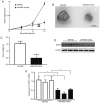miR-944 inhibits lung adenocarcinoma tumorigenesis by targeting STAT1 interaction
- PMID: 30881499
- PMCID: PMC6403514
- DOI: 10.3892/ol.2019.10045
miR-944 inhibits lung adenocarcinoma tumorigenesis by targeting STAT1 interaction
Abstract
Lung adenocarcinoma (LAC) is a leading cause of cancer-associated mortalities, particularly in developed countries. The aberrant expression of microRNAs (miRNAs) has been proven to regulate numerous diseases in the past two decades. miRNAs have been identified in almost all human cancer types. In the present study, the role of miR-944 in LAC proliferation was examined. It was identified that miR-944 was downregulated in LAC tissues and cells, and miR-944 overexpression inhibited A549 and H1299 cell proliferation, as determined by the Cell Counting Kit-8 and colony formation assay. Signal transducer and activator of transcription 1 (STAT1) was upregulated in LAC tissues and cells. Kaplan-Meier analysis demonstrated that the 5-year overall survival in patients with high STAT1 levels was significantly reduced, compared with patients with negative and low STAT1 expression. STAT1 was the direct target of miR-944. Additionally, a miR-944 mimic inhibited A549 cell growth in vitro. Collectively, these data demonstrate that miR-944 serves a pivotal role in LAC tumor growth by targeting STAT1. The data obtained indicated that miR-944 may be a novel biomarker and could result in potential therapies for LAC.
Keywords: lung adenocarcinoma; microRNA; proliferation; signal transducer and activator of transcription 1.
Figures





References
-
- Ni J, Zhou LL, Ding L, Zhao X, Cao H, Fan F, Li H, Lou R, Du Y, Dong S, et al. PPARγ agonist efatutazone and gefitinib synergistically inhibit the proliferation of EGFR-TKI-resistant lung adenocarcinoma cells via the PPARγ/PTEN/Akt pathway. Exp Cell Res. 2017;361:246–256. doi: 10.1016/j.yexcr.2017.10.024. - DOI - PubMed
LinkOut - more resources
Full Text Sources
Research Materials
Miscellaneous
